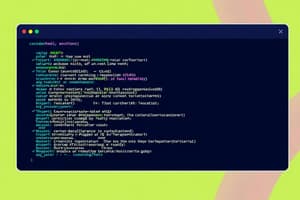Podcast
Questions and Answers
Apa yang dimaksud dengan tag dalam HTML?
Apa yang dimaksud dengan tag dalam HTML?
- Judul untuk sebuah halaman web
- Memberikan deskripsi alternatif untuk gambar
- Organisasi konten di sebuah halaman web (correct)
- Menentukan lokasi file sumber untuk gambar
Apa fungsi atribut 'src' dalam HTML?
Apa fungsi atribut 'src' dalam HTML?
- Menentukan URL yang data formulirnya akan dikirimkan
- Menentukan lokasi file sumber untuk gambar (correct)
- Memberikan deskripsi alternatif untuk gambar
- Judul untuk sebuah halaman web
Bagian HTML mana yang berisi metadata dan judul halaman?
Bagian HTML mana yang berisi metadata dan judul halaman?
- (correct)
Apa fungsi dari tag dalam HTML?
Apa fungsi dari tag dalam HTML?
Atribut 'action' dalam tag HTML digunakan untuk apa?
Atribut 'action' dalam tag HTML digunakan untuk apa?
Apa manfaat dari menggunakan tag dalam HTML?
Apa manfaat dari menggunakan tag dalam HTML?
Apa fungsi dari atribut 'for' yang bisa disematkan pada label dalam form HTML?
Apa fungsi dari atribut 'for' yang bisa disematkan pada label dalam form HTML?
Bagaimana struktur halaman web dapat memengaruhi SEO menurut teks di atas?
Bagaimana struktur halaman web dapat memengaruhi SEO menurut teks di atas?
Apa perbedaan utama antara 'footer' dan 'address' dalam konteks HTML?
Apa perbedaan utama antara 'footer' dan 'address' dalam konteks HTML?
Mengapa penggunaan tag penting dalam pembuatan formulir HTML?
Mengapa penggunaan tag penting dalam pembuatan formulir HTML?
Flashcards are hidden until you start studying
Study Notes
HTML: Understanding Tags, Attributes, Structure, and Forms
HTML (Hypertext Markup Language) is the standard markup language for creating web pages. It provides the structure of a webpage and defines how different components interact with each other. This guide explores HTML's essential aspects, including tags, attributes, structure, and forms.
Tags
Tags are used to organize content on a webpage. They provide context to web developers and help search engines understand the content. Some common HTML tags include <h1> for headings, <p> for paragraphs, and <img> for inserting images.
Attributes
Attributes modify the behavior or appearance of a tag. For example, the src attribute specifies the source file location for images (<img src="image.jpg">) and the alt attribute provides alternative text descriptions (<img src="image.jpg" alt="Description of image">).
Structure
HTML uses a hierarchical structure to define relationships between different sections of a webpage. From outermost to innermost, these sections can be classified as follows:
- Document: Encompasses everything within the
<html></html>tags. - Head: Contains metadata and titles within the
<head></head>tags. - Body: Includes visible webpage content within the
<body></body>tags.
Forms
Forms allow users to submit data to a server. They consist of several input fields, such as text boxes, radio buttons, checkboxes, and drop-down menus. Common form-related tags include <form>, <input>, <label>, and <button>. The action attribute in the <form> tag specifies the URL the form data will be submitted to.
In conclusion, HTML provides the foundation for creating dynamic, interactive web pages. By understanding its fundamental concepts, such as tags, attributes, structure, and forms, developers can create engaging and user-friendly web experiences.
Studying That Suits You
Use AI to generate personalized quizzes and flashcards to suit your learning preferences.




